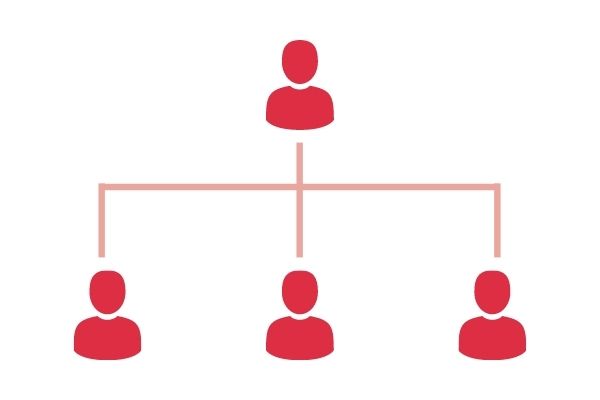This post covers the most common Korean job titles and their duties.
It will show you how to find out:
- who is important
- how to address them
- how long it takes to get promoted
I learned about Korean corporate titles at my first job.

Essential Tips
- Using job titles correctly is a must in Korea.
- Avoid using kinship terms such as unnie, hyung, oppa or noona at work.
- Understanding corporate hierarchy is a big part of adult life in Korea.
Korean job titles are formal names for specific positions within an organization. They’re based on Korean social norms and have deep cultural ramifications.



Job Titles
Executives
회장 Hwe-jang (Chairman / CEO)
The Chairman or CEO holds the highest position in a Korean company. He/she rarely makes an appearance in front of employees as they are in charge of establishing the company vision.
They are the main decision makers and financial shareholders in a company.
대표 Dae-pyo (Representative / Head / Chairman / CEO)
This position is very similar to Hwe-jang. The main difference is how each title sounds to Koreans.
While Hwe-jang conjures up the image of a very old man, not unlike Mr. Burns, Dae-pyo feels much younger to Koreans. It’s basically the CEO role, but for younger companies like startups.
As seen in many K-dramas, most CEOs are called “Dae-pyo-nim”.
사장 Sa-jang (President / COO)
The President or COO is the right hand of the Hwe-jang. He/she is in charge of a particular business division in the company and sets comprehensive goals for growth.
Also, anyone who opens up a business can be called “Sa-jang”. This includes restaurant and store owners.
전무 Jeon-moo (Executive Director / CFO)
The CFO heads the finance department of a company and makes major decisions related to finance, investment planning and risk management.
상무 Sang-moo (Vice President)
Sang-moo is a title for senior directors who are the head of a department, but have more experience than the Ee-sa (Director).
이사 Ee-sa (Director)
The director of a Korean company is considered to be the younger department head. This person makes important department-related decisions and implements them.
사외 이사 Sa-oe Ee-sa (Outside Director)
After the 1997 IMF Financial Crisis in Korea, this position was borrowed from the U.S. corporate system to allow for more company oversight through unbiased opinions.
Like in the U.S. they are not employees of the company and instead serve on the board of directors.
고문 Go-moon (Advising Director)
Go-moon provides opinions and advice with his/her expertise and experience in a specific field. In Korea, Go-moon is often an honorary position that does not go to work or work regularly.
감사 Gam-sa (Auditor)
Gam-sa inspects and verifies whether the corporation is properly processing the accounting in accordance with the laws and the articles of association.
In Korea, it is normally the second position in the company who monitors the work of the CEO.
수석 부장 Soo-seok Bu-jang (Chief General Manager)
The department head is in charge of the operations of their assigned department. He/she handles recruitment, supervises managers and is responsible for the performance of that department.
실장 Shil-jang (Department Head)
Literally translates to “head of the room” or “chief of the section”. This title is used when departments are divided into different sections using the suffix of Shil (실).
Slightly less senior than the above mentioned Ee-sa (director), but similar in job role/scope.
Job Titles
Staff
부장 Bu-jang (Team Leader / Head Manager / Senior Manager)
The senior manager is also referred to as the head manager and is the same level as the team leader. He/she manages teams responsible for working on specific current projects. 10 years of experience is necessary to become a Senior Manager.
차장 Cha-jang (Deputy Team Leader / Senior Manager)
The deputy team leader makes sure that all members of their team are assigned specific roles.
과장 Gwa-jang (Manager)
A manager must have 7 years of experience in a relevant industry. He/she is responsible for managing team members while working on projects. They are the project leaders.
대리 Dae-ri (Assistant Manager)
Assistant managers are just below managers and assist them with projects. They perform basic administrative duties and provide support for day-to-day tasks.
주임 Ju-im (Senior Staff / Assistant Manager)
An in-between level. Not all companies have a Ju-im but they are basically a step up from a graduate worker. Sometimes when a new employee has a Masters or Doctorate, they are automatically promoted to this level.
The main difference from Sa-won is a small pay increase.
사원 Sa-won (Regular Staff / Assistant / Officer)
Regular staff members work within teams headed by managers or team leaders. They are slightly higher than entry level employees.
신입 사원 Shin-ip Sa-won (New Graduate Employee)
These are employees who have just been hired after graduating from university. Unlike in other countries, they often have no real work experience and need to be taught basic office etiquette.
This is because the Korean Education System is competitive, so they spent most of their life studying.
Other Positions
반장 Ban-jang ((Field) Foreman / Squad Leader)
조장 Jo-jang ((Field) Leader / Group Leader / Junior Mechanic)
판매사원 Pan-mae Sa-won (Sales Clerk)
비서 Bi-seo (Secretary)
운전기사 Woon-jeon-gi-sa (Driver)
용역 Yong-yeok (Hired Services)


Facts about Korean job titles
Based on Chinese characters, job titles determine your position in Korean society.
They’re similar to military rank.
Since all males perform mandatory military service, you can expect a similar environment in the workplace.
Job titles in English can be inconsistent with their Korean translation.
Some people use inflated titles in English, especially on business cards.
No matter what a person’s position is in English, the Korean title is the only one that matters.
Learning someone’s Korean job title is the best way to find out their level in a company.
Even though Korean companies are becoming more relaxed with the increase in start-ups and overseas subsidiaries, they are still run top down.
I once went to a Korean tourist agency in Brisbane, Australia, and thought I was back in Seoul when I stepped inside. It had the same level of formality and protocol as a Korean office.
It’s vital that you refer to someone by the correct title.
Always make sure to say their full name followed by their title and add a ~님 (~nim) at the end as a sign of respect. This will help build 정 (Jeong) or rapport and make your life easier.
Here are the most commonly used Korean Job Titles.
How long does it take to get promoted in Korea?
Until the Gwajang level, promotion is somewhat automatic, provided you show up and don’t make waves.
Companies tend to have different HR policies, so the time frames may vary.
Normally, when a company has the Ju-im title, it takes this long to get promoted:
Sa-won → Ju-im = 2 years
Ju-im → Dae-ri = 2 years
Dae-ri → Gwa-jang = 3-4 years
Gwa-jang → Cha-jang = 5-6 years ± performance
Being promoted from Gwa-jang to Cha-jang can depend on your performance.
After that, only exemplary employees make it to Bu-jang and above.
Promotion can take as little as 2 years at smaller companies or sales-related positions.
For larger companies, it can take anywhere from 10-12 years to make it to management.
How to Use Job Titles

There are three job title terms: 직위 (jik-wi, position), 직급 (jik-geup, job grade or rank), and 직책 (jik-chaek, duty or responsibility).
Don’t worry if this is confusing at first. Even Koreans have trouble understanding the differences and need to learn them during their first job.
직위 (Position)
A position refers to a ‘social and administrative position defined by a job’, or a basic corporate hierarchy.
This category includes Bu-jang(Vice President), Cha-jang(Manager), Sa-won(entry-level position), etc.
The basic structure of positions is nearly identical everywhere.
However, positions differ slightly depending on the company or have different names.
The basic hierarchy system is as follows:
Regular Positions: Sa-won < Ju-im < Dae-ri < Gwa-jang < Cha-jang < Bu-jang
Executive Positions: Ee-sa < Sang-moo < Jeon-moo < Bu-sa-jang < Sa-jang < Bu-hwe-jang < Hwe-jang
직급 (Job Grade)
A job grade refers to the rank of a job.
It’s a way of ‘grouping positions with similar types, difficulties or responsibilities of work’.
Job grades are more common for government officials or public servants under 호봉제 (ho-bong-je, salary system).
They’re not used often in general corporations, but the nuance is similar to Nth-year dae-ri or gwa-jang.
직책 (Duty)
A duty refers to ‘main occupational responsibility’.
Often a Team-jang, Bon-bu-jang or CEO belongs in this category.
Since a duty is assigned according to your responsibilities and authority, it sometimes stays the same after you’re promoted.
Duty: Part-jang < Team-jang < Shil-jang < Bon-bu-jang < CEO, CFO, COO
직함 (Title)
A title refers to both position and duties in Korea.
We recommend asking what someone’s title is when you want to learn their position.
If all else fails, this is the best way to find out someone’s rank in a company.
Addressing Someone in a Company
In everyday situations, you can address a superior with his/her last name and their position, such as ‘김 부장님 (Kim Bu-jang-nim)’.
For more formal situations, make sure to use the last name, then first name followed by their position, such as ‘김철수 부장님 (Kim Cheol-su Bu-jang-nim).
However, if you are on the same team or their duties are clear, it’s better to call them by their duty, such as ‘팀장님 (Team-jang-nim)’ or ‘본부장님 (Bon-bu-jang-nim)’.
Addressing a Superior: ‘Last Name’ + Position + Nim
Addressing Colleagues: If a colleague has the same job grade = Last Name + Position, or First Name + Ssi (i.e., ‘이 대리 (Lee Dae-ri)’ or ‘___씨 (__ Ssi)
If a colleague joined the company before you, but doesn’t have a title = ‘선배님 (Sun-bae-nim)’
If a colleague joined the company before you, but has the same job grade or is older than you = Last Name + Position + Nim (i.e., ‘이 대리님 (Lee Dae-ri-nim)’)
Addressing a Subordinate: If a subordinate has a duty = Last Name + Duty (i.e., ‘박 주임 (Park Ju-im)’)
If a subordinate doesn’t have a duty = First Name + Ssi (i.e., ’__씨 (__ Ssi)’)
When in doubt, 직함 (jik-ham, title) is the most important, which combines 직위 (position) + 직책 (duty).
For example, When someone asks in a polite way:
“직함이 어떻게 되십니까? (What is your title?)”
The answer can be:
“저는 _____회사 대리 김__입니다. (I am Dae-ri of ___ company, Kim __.)”
Job titles influence everything, including the way you dress and even write emails. They’re vital if you plan on:
Getting a Job in South Korea
Doing Business in Korea
Starting a Business in Korea as an Expat
FAQ
How do you say CEO in Korean?
There are two ways to call someone CEO in Korea depending on what type of company they run.
회장 Hwe-jang is the most common way to refer to a CEO at an older company in Korea.
대표 Dae-pyo is a popular way to refer to the head of a startup or younger company in Korea.
Koreans are aware of the term CEO as well, so you won’t offend anyone by accidentally referring to someone as such.
How do you say director in Korean?
This depends on which type of director you’re referring to.
When referring to the Korean corporate title of director, it’s 이사 – Ee-sa.
If you’re referring to a film director, it’s 감독 – Gam-dok
How do you say manager in Korean?
There are many types of managers in Korea, but 과장 – Gwa-jang is the standard way to refer to them.
Conclusion
Job titles influence how business is conducted in South Korea.
I spent a good portion of training at my first job studying them.
Don’t worry if you make a mistake though. You won’t be judged as harshly as a local would be.
Let us know if you have any questions in the comments!



